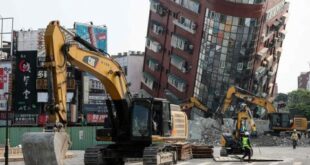Elevated temperatures, historic drought and deforestation contributing to wildfires in the tropical rainforest
Fire is sucking the life out of parts of the Amazon rainforest. In Roraima State, in northern Brazil, the number of fires in February were more than five times the average, according to data from Brazil's National Institute for Space Research, and blazes continued to burn through March.
"We are losing the Amazon rainforest. These changes in the climate right now provoked by El Niño makes this forest fire season even worse than we are used to seeing in the forest," said Marcio Astrini, executive secretary of Brazil's Climate Observatory.
Wildfires in the normally humid, tropical rainforest have been supercharged by a disastrous combination of elevated temperatures, historic drought and deforestation.
Even as the year-old government of Luiz Inácio Lula da Silva has brought down the rate of deforestation in Brazil by more than 20 per cent, a hot dry 2023 stressed the trees within the Amazon, which stretches into eight countries.
Analysis by Copernicus, a European atmospheric monitoring service, estimates that fires in Brazil released the highest amount of carbon dioxide for the month of February in over two decades. Half of the 45.1 megatons of CO2 released, it reported, came from the fires in Roraima state.

Record wildfires in the Amazon in February. That’s not normal
11 hours ago
Parts of Brazil’s Amazon rainforest saw more wildfires in February than in all of 2023 — and that was already a bad year. CBC’s Susan Ormiston breaks down why it’s happening and why it could signal a devastating tipping point for the rainforest.
"[In] Colombia, Venezuela, Guyana, you also see very high fire activities. This is another kind of proof that the climate is playing a very important role in that," said Ane Alencar, science director for the Amazon Environmental Research Institute.
'Prone to be burned'
The Amazon is one of the world's largest carbon sinks, capable of storing more than 150 billion metric tonnes of carbon, equivalent to about 10 years of global greenhouse gas emissions. But with abnormally high temperatures, the majestic green canopy begins to suffer.
"The first thing that the trees do, they shed their leaves and you have right there very good fuel material for the fire," Alencar told CBC News.
"At the same time that you open the canopy, you allow the exchange of dry air with moist air. So you make that microclimate condition internally in the forest more prone to be burned."
Back in September, as the wildfire season began to wane in North America, Brazil was experiencing the effects of a crippling drought, which began last March. People in Manaus, one of the hubs of the Brazilian Amazon, were choking on smoke.
Alencar says she checked the levels of particulate matter in the air and compared it to the worst of the fires in Quebec, which sent smoke as far as New York last June, making international headlines with photos of red hazy air hanging over Manhattan.
The levels were the same or worse in the Amazon, she said. Indigenous communities were breathing that level of smoke daily, but without the outcry observed in North America, according to Alencar.
"This year, we have felt this huge change. The air and the humidity is very low and this has also led to problems with illnesses in families, especially in children," said Cesar Da Silva an Indigenous leader.
Parts of the Amazon River basin withered, such that transport by boat was nearly inaccessible and mounds of dead fish floated to the surface because of the abnormally warm water. In October, the Amazon's main tributary, Rio Negro, was the lowest it had been since annual records began in the early 1900s.

Efforts to curb illegal deforestation
Even with gains made to protect the forest under President Lula da Silva, some parts are already 40 per cent deforested, according to Luciana Gatti, a greenhouse gas specialist and researcher with the Brazilian National Institute for Space Research.
Efforts to curb illegal deforestation are still met with stiff resistance from powerful ranching interests in states still controlled by supporters of former Brazilian president Jair Bolsonaro's party.
"We are no longer facing Bolsonaro's term, but the politics that try to undermine forest protection in Brazil is really alive, it's still operating in the country," said Astrini.
"International pressure, international surveillance is absolutely important and makes a difference," he said.
Last week, France and Brazil announced an investment plan to raise over 1 billion euros to help protect the forest.
International funds had dipped during Bolsonaro's presidency; in 2019, Bolsonaro accused Macron and other G7 countries of treating Brazil like "a colony."
"After a four-year eclipse and a virtual freeze in political relations between our two countries during Bolsonaro's presidency, we are in the process of relaunching the bilateral relationship and the strategic partnership with Brazil," a French presidential adviser told Reuters on Friday.
Money can't cool the climate
Scientists forecast the El Niño weather pattern, which helped exacerbate the drought, will wane throughout the end of this year. But few are predicting what 2024 will bring, with high ocean temperatures still setting records.
The parts of the Amazon above the equator are heading into a rainy season, but it has been delayed. Below the equator in Brazil, the rainforest is entering fall, when it normally gets drier and warmer, and there are concerns about a lack of rainfall to feed the rivers and lakes.

"We [are] arriving at a very dangerous limit for the Amazon, and not everybody is observing that we are very near this limit," said Gatti.
But the coming year is sending red flag warnings. Money can help with monitoring and efforts to curb deforestation, but it can't cool the climate, and 2024 could break temperature records again.
"We need to do something like [consider this] an emergency situation. We cannot wait," said Gatti.
*****
Credit belongs to : www.cbc.ca
 MaharlikaNews | Canada Leading Online Filipino Newspaper Portal The No. 1 most engaged information website for Filipino – Canadian in Canada. MaharlikaNews.com received almost a quarter a million visitors in 2020.
MaharlikaNews | Canada Leading Online Filipino Newspaper Portal The No. 1 most engaged information website for Filipino – Canadian in Canada. MaharlikaNews.com received almost a quarter a million visitors in 2020.







